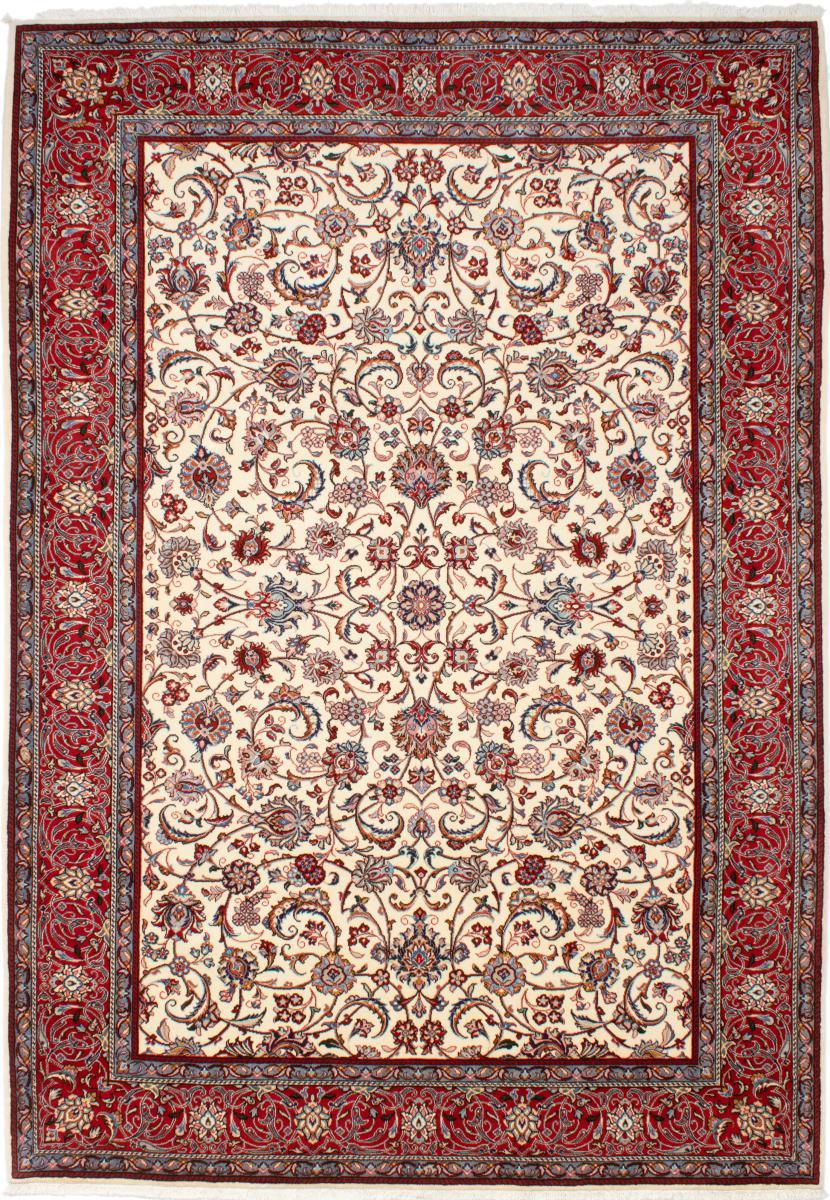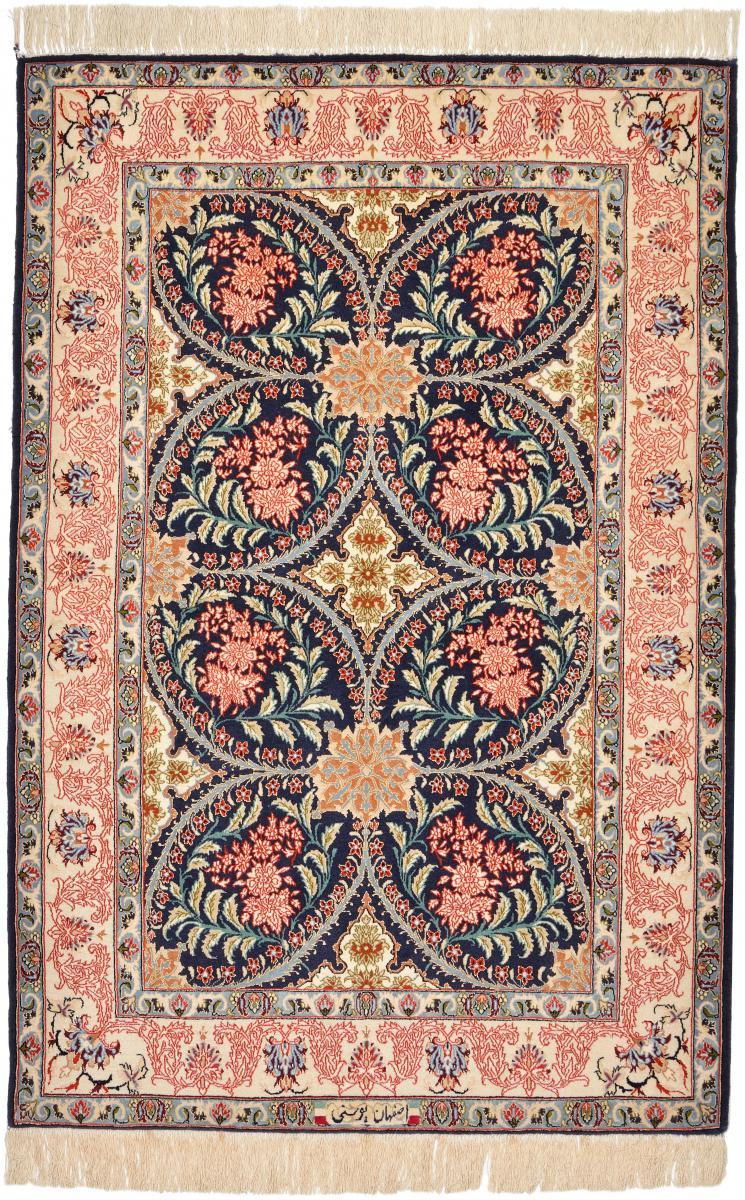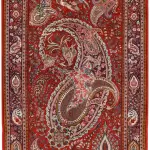All kinds of garden carpets
Garden motifs are one of the various designs of Iranian carpets, in which elements such as trees, flowers, streams and water ponds, and all kinds of birds and animals are used. In the previous articles, we introduced garden carpets and its elements. In this article, we are going to examine the types of beautiful garden carpets and describe the characteristics of each one.
The oldest garden carpets
Regarding the oldest design of the garden in the carpet, after the Pazyrik carpet, written sources refer to the Sassanid Baharestan carpet. In the description of this carpet, it is mentioned that: it was woven for the winter when there were no flowers or greenery, and when they wanted to eat, they sat on it as if they were in a garden... a single acre-sized area in which there are illustrated paths and fountains like The streams... and the borders were like fields and green fields of spring, but as mentioned, most of the Golestan pattern carpets are from the Safavid period onwards. In total, the number of existing and remaining carpets of this role in the world reaches twenty.
Classification of garden carpets
Garden carpets can be divided into two main categories based on their designs:
A- Garden designs that are accompanied by geometric divisions (chalipai) in the field of carpets, which show the effort of the Iranian mystic artist to visualize and depict heavenly concepts in a way that is understandable and compatible with the perception and material and tangible mind of the earthly man. In garden carpet designs, the two main axes are in the form of four water streams, the carpet area is divided into four geometric parts, which reminds of the four garden design in Iranian garden and campus architecture, as in the garden carpet in Pennsylvania, the four parts of the garden are separated by the stream. And in each part there are patterns of trees and flowers.
B- In other garden designs, the aspect of coding is more visible, in this way, there is no mention of geometric division and water streams, and the space of the carpet is wide in such a way that the divine safe space is obvious in it, and trees, animals, mysteries and mythological characters. and mystical are all placed together on the text and the border of the rug. This is the reason why these carpets often use elements such as trees, peacocks, fish, and simorgh, and to show human efforts in the material world, motifs and concepts such as grip and grip are used. In fact, it is these divine concepts that find a special effect in the design and pattern of Iranian garden and paradise carpets, as in the design of carpet motifs in the form of an anhar effect and the planting of plants and trees in the form of four gardens.
Carpets with garden maps
The carpets that show the plan and physical map of the garden, the original Iranian name for these maps is Golestan, which is also known by the same name (golistan) in Turkey due to its popularity since ancient times. In the Safavid period, apparently, this type of garden carpet was also called Gulzar.
Carpet with Golestan design
This type of garden carpet has several (about seven) floral borders, including a wide border, usually full of flowers, trees, or flowers and nightingales, and a text that is divided into several basic parts (four, six , eight and the like) and each part has six and sometimes four parts, so that the division with multiples of six (or twelve or twenty-four) is observed in it. The movement of water in streams is shown by wavy lines and blue color. There are fish and birds in the streams. It can be seen how the map of Minoan garden [extensive] is on the carpet. In other words, in the Golestan design, the garden wall is seen as a carpet border. Also streams, garden plotting, location of the pavilion or the main water feature of the garden and all natural components and elements including flowers, plants, trees, animals, birds are displayed abstractly. It can be said that an Iranian carpet with a garden pattern is an exaggerated representation of an Iranian garden with all its allegories and symbols [and from the shape point of view] an Iranian carpet is a two-dimensional work of art that is considered a three-dimensional reality.
Brick or frame design
In this design, the main background of the carpet is connected in the form of square, rhombus or rectangular frames, and the inside of each frame is decorated with a pattern of flowers, bushes and decorative trees. This design can be a direct summary of the maps of Golestan, because it is not surprising that this map remains commonly in the west of Iran, which is the cradle of ancient Iranian civilization and a special tradition in weaving. [Design] The old adobe in Chaharmahal tells in the most eloquent way that it is a relic of the map of Golestan and along with the change of beliefs, it has completely acquired a decorative and local color. As mentioned before, this design has many similarities with the geometric structure and system of the garden and especially the garden plots, which with a certain planting system, a type of trees and flowers are planted in each plot, and this issue is completely in the carpets with clay pattern. it is obvious.
Tangerang and Tangerang design
In Iranian carpet designs, the central role of the carpet has a special place and it is mainly in the form of square, rhombus, oval, round and sun, star or multi-feathered flowers, which are called bergamot. The bergamots are used in different geometrical shapes, three bergamots, bergamot leaves, nested bergamots, etc. in the design of carpets. The bergamots are the central reservoirs of Bagh Pardis, which have gradually become the bergamot and the source of water (the two fertile arms of the earth). In fact, the map of Taranj emerged from the map of Golestan because instead of showing the whole garden, which was almost impossible to draw in detail, they showed a corner or part of it with a stream and three, four or five reservoirs. It is interesting that the connecting stream of these bergamots is also called Golugah or Boghaz in Iran, which is usually used for waterways. From the plans of the bergamot, the design of several bergamots, especially the three bergamots, emerged, and later this design became the bergamot. Therefore, the maps of Lech Taranj are children of the Golestan map, that is why in many parts of Iran, Taranj is also called a pond or a pool. Also, this is the reason for the presence of many flowers and plants in the maps of Lech Taranj. Obviously, as a result of the passage of time, the evolution of ideas in the beliefs of Iranians, and also due to the idealistic taste, some elements were introduced in Lakh Taranj map.

Flower-blowing design
In this design, motifs of different flowers such as Shah Abbasi, Khataei, Ghancheh and Slimi are placed separately and scattered and without continuity at equal distances from each other and sometimes similar, and it seems that they have been sprinkled on the carpet text. All these flowers, which are abstract patterns or similar to natural flowers (according to the researches, all types of flowers have been identified in Iranian carpets, including real or abstract designs of tulips, narcissus, lily, red, and trumpet flowers) , lily, violet, etc. pointed out that it is even possible to identify a specific type of plant in the period related to the history of carpet weaving), are displayed and placed inside the frame or border of the carpet. Also, some medicinal plants can be recognized by their patterns in the carpet.
hunting ground plan
This Iranian carpet and rug design is a hunting ground and shows flowers, plants, animals and their hunting situations. Hunting ceremonies have been common in Iran for a long time, during the Achaemenid period, lion hunting took place around Persepolis. All kinds of animals can be seen in the state of facing or grasping in the sculptures of Pasargad and Persepolis, Simin cups, textiles and all manifestations of life. In these designs, the lion is being hunted as a symbol of courage, bravery, and love, and this design can be seen in the Shekargah design carpets, which is closely related to the vast Iranian garden design with the function of the Shekargah. It is also shown in some carpets with the hunting design of the central pavilion of the garden. The famous hunting rugs show a person in the middle of a landscape of flowers and plants, and sometimes a booth that pokes its head out of the foliage of trees is also seen.
Carpets with garden elements
In this section, we will briefly examine carpets with garden elements, which can somehow be included in the category of garden carpets. Some of these physical elements of the garden have remained as a permanent part of the design of the carpets: such as the border of the Persian carpet, which is a symbol of the surrounding wall of the garden, and some parts and elements of the garden have clearly created a separate design. Like the carpets with the design of the altar, which is taken from the entrance gate of the gardens.
Carpet border or garden wall
The peripheral wall of the Iranian garden, with all its functional and semantic systems as well as its physical characteristics, is one of the characteristics of the Iranian garden, which is displayed in the Persian carpet design as a carpet border. Paradise, as it comes from its root meaning (pairidaeza), is a garden surrounded by several (usually seven) fences in a row, one of which is the tallest and widest (thickest) of all, so that the devil cannot get into it. . The frequent borders [usually seven or five] and especially a broad and distinct middle border in Iranian carpets are the same frequent walls of Firdos. The border of the Iranian carpet, like the wall of the Iranian garden, has become one of the prominent and stable features of the Iranian carpet design. For example, in Kerman carpets, usually the main border is woven together with two pairs of side borders, the width of the main or middle border is usually twice the sum of the secondary borders. Sometimes in some vegetable and tree designs or flower beds, the border is not woven and the narrow border is woven. A ratio between the width and narrowness of the edges and the width of the carpet is observed, which is one sixth in the western school and central parts of Iran and one fifth in the eastern parts. In the northern regions of Iran and the Caucasus, borders are made in large numbers with regular geometric patterns, and these proportions are sometimes ignored in different centers and the borders are woven wider or narrower. The border of the carpet garden or the garden enclosed between the walls is mostly decorated with various motifs, which are sometimes in harmony with the main design of the carpet; That is, they are woven using the motifs of the text but with new combinations. Sometimes the designs are simply woven in the traditional way with the help of wavy silks, twisting vines, inscriptions with different lines, abstract animal motifs.
Mihrab design (water seal)
Janmazi carpets always show a shape reminiscent of mosque altars. Mihrab, which is the shape and design of architecture, is the gate of heaven. The motifs inside the altar are often with the image of the tree of life, a vase, a garden with flowers, plants, bushes, trees, chickens, and various birds. The altar is reminiscent of the entrance to this garden. The most famous Iranian carpet with a mihrab is the Gate of Heaven or Mihrabi Dornama.
Arabesque designs
Slimes are very abstract motifs of plants that are made up of wavy twists and turns like the tendrils of the love plant or the branches of the hair trees, and in the meantime, the tendrils have more geometric shapes and consist of a set of lines that join each other, intersect and sometimes intersect. They complete and repeat like a perfect weight and analogy. The design of Slimis in the carpet is reminiscent of the tree of life in the mental beliefs of ancient Iranian culture and the Tobi tree in the beliefs based on the Islamic religion, the dynamics of these motifs creates an extremely dense world of plants, such as natural and artificial elements, and prevents focusing on the details of the scene. It is in the carpet. Because these carpets are also inspired by the elements of nature, they can be classified as garden carpets.
Final word
As we have seen, the hand-woven carpet with a garden design is one of the most beautiful Iranian carpets. In these carpets, beautiful elements such as trees and plants, flowers and bushes in different shapes, streams and ponds, as well as all kinds of animals and birds are used to represent the famous Iranian Chaharbagh and finally Paradise and Paradise. In this article, we examined the types of garden carpets and we saw that the garden design is manifested in Iranian carpets in various formats such as Lakh and Taranj, Afshan, Golestan, Mehrabi, Khashti, etc.
You can inquire about Buying Handwoven Carpets , Buying Handwoven Kilim and Mats , and Buying Handwoven Pictorial Rug Tableaus online from the Hoveida Carpet Store and register all your orders and Wherever you are in the world, deliver it to the desired address in less than 4 working days.
If you are interested in reading other articles in the field of Handwoven carpets or Handwoven Pictorial Rug Tableaus , please refer to Hoveida Carpet Commercial .
Leave a comment
Your email address will not be published. Required fields are marked *












